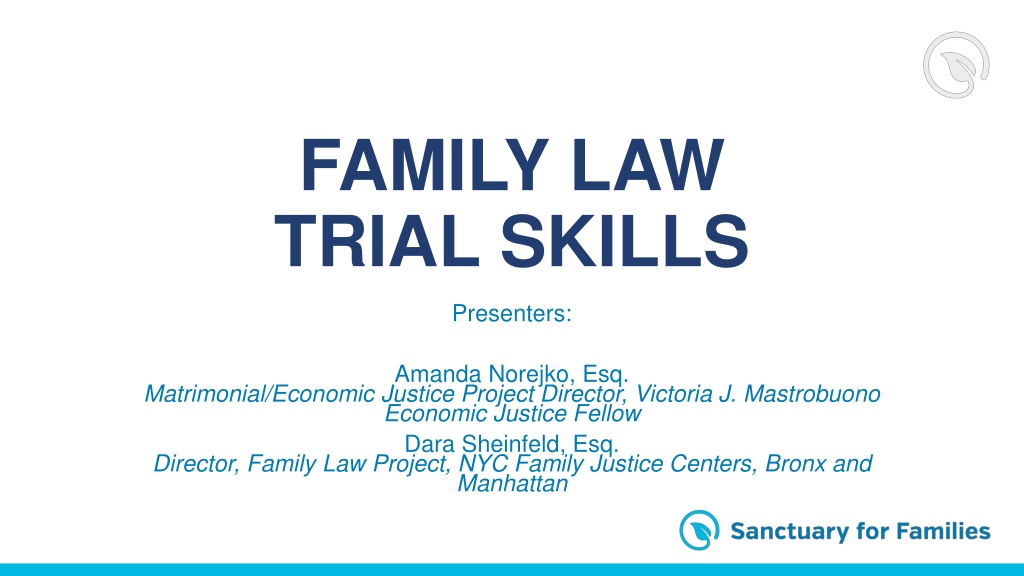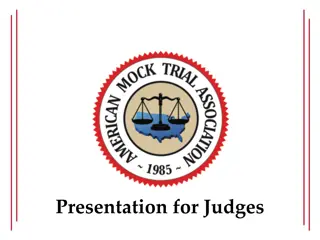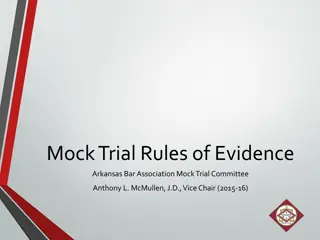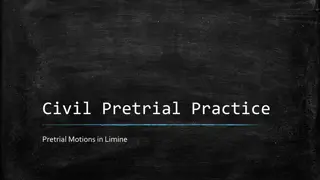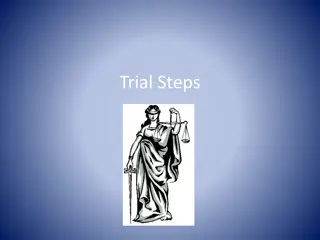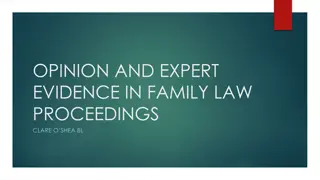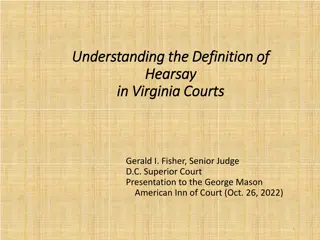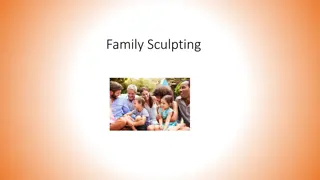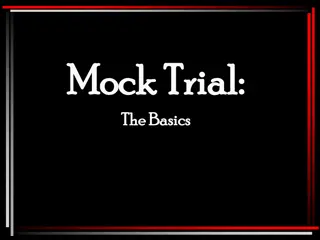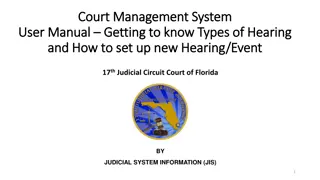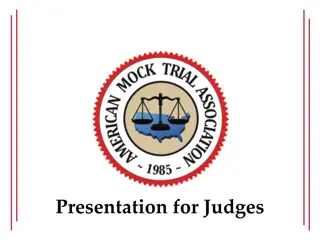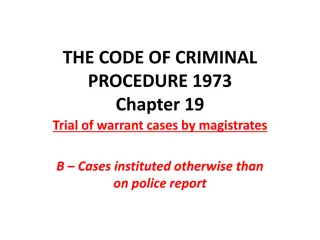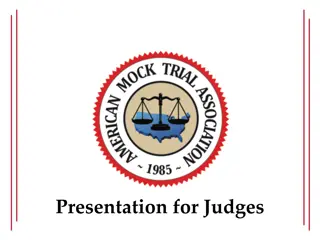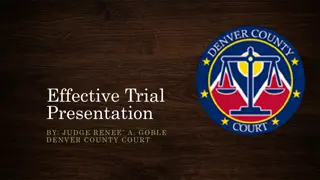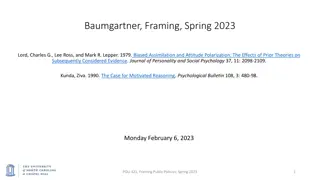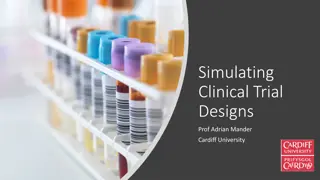Family Law Trial Skills Workshop: Evidence Collection and Trial Techniques
Enhance your trial skills in family law with a focus on evidence collection, trial strategies, and client examination. Learn best practices for preserving evidence, drafting persuasive statements, and navigating trials confidently. This workshop covers important aspects of evidence collection, such as obtaining client documents, preserving records, and preparing for trial effectively.
Download Presentation

Please find below an Image/Link to download the presentation.
The content on the website is provided AS IS for your information and personal use only. It may not be sold, licensed, or shared on other websites without obtaining consent from the author. Download presentation by click this link. If you encounter any issues during the download, it is possible that the publisher has removed the file from their server.
E N D
Presentation Transcript
FAMILY LAW TRIAL SKILLS Presenters: Amanda Norejko, Esq. Matrimonial/Economic Justice Project Director, Victoria J. Mastrobuono Economic Justice Fellow Dara Sheinfeld, Esq. Director, Family Law Project, NYC Family Justice Centers, Bronx and Manhattan
What You Will Learn Identify best practices for evidence identification, collection, and preservation for Family Court litigation Learn how to draft powerful and effective opening statements and closing arguments Learn proper techniques for direct examination of your client and cross examination of the abusive party Gain the tools needed to approach trials with confidence
What This CLE is Not Not about how to admit documents at trial Not about how to make objections at trial Not about cross examination of forensic experts Not about the substantive law on custody, visitation, child support, orders of protection, and divorce
Early Evidence Collection Goal is to preserve available evidence Evidence collection is an ongoing responsibility Responsibility starts at first meeting after you are retained Begin with your client s own records that she can easily obtain Hospital Records Police Reports Phone Records (Call History) Copies of Text Message Communications with Abusive Party Copies of Emails To/From Abusive Party ACS Records Credit Card Statements
Attempt to Obtain Clients Documents Without Subpoena Benefit: Can review before putting in the hands of opposing party Must include Certification and Delegation forms with request so documents will be certified CPLR 4518 Get business records with the required certification and delegation of authority to make them admissible without calling the custodian of records to testify
Obtaining Clients Medical Records Must submit properly executed HIPAA form to Medical Facility Initialing all boxes Including date of expiration For opposing party s medical records, if opposing party will not consent to signing a HIPAA form, counsel may submit an Order Authorizing Disclosure of Patient Records Under 42 Code of Federal Regulations 2.61-2.64 Ordered by the Court and submitted to applicable health care provider
Mental and Physical Health at Issue in Custody Matters Parties to a custody proceeding place their physical and mental condition at issue Rosenblitt v. Rosenblitt, 107 A.D.2d 292, 486 N.Y.S.2d 741 (2d Dep t 1985).
Interviewing the Survivor re: Evidence Victim is usually the main source of evidence Spend time (hours); Ask specific questions Advise her and family/friends not to block or unfriend abuser, and not to destroy evidence (spoliation) BUT avoid retraumatizing Allow victim to decide; talk it through Be sensitive in your questioning Attorney may need to gather evidence directly Be cautious about having the client engage with abuser
Helpful Electronic Evidence Client s Phone Text Messages, WhatsApp, voicemails, missed call log Photographs Videos Recorded phone calls Abuser s Instagram, Twitter, and/or Snapchat Email Forensic Evidence of Hacking or Spyware
Ethical Issues in Gathering Evidence N.Y. State Ethics Opinion 843 (Sept. 10, 2010) Attorneys may view the public social media profiles of opposing parties/witnesses. Attorneys may not friend represented parties, or direct third parties to do so. NYC Bar Ethics Opinion 2010-2 Attorneys (and their agents) may friend unrepresented party without disclosing litigation purpose, but not using any deception Rule 4.1 false statements of fact or law Rule 4.2 contact with a represented party Rule 4.3 misleading about lawyer s role or interest Rule 5.3(b)(1) responsibility for directing unethical conduct by nonlawyers Rule 8.4 deceptive or misleading conduct
Audio and Video Recordings CPLR 3101 (I) evolved due to advancements in and increased use of surveillance materials, such as film, video tapes, audio tapes and photographs, including transcripts or memoranda of said materials. Unedited copies of such material must be produced when demanded. A party may not produce only those portions of the video, for example, that the party intends to produce at the hearing. All out-takes must be included in the materials to be produced. This provides an opportunity for disclosure of all materials prior to trial. In the event the materials are not disclosed, the party who demanded the production may object to their being introduced at trial.
Remember Future Evidence In electronic communications with abuser: No threats or contact in violation of OP Custodial parent must foster positive relations with other parent Avoid jealous ex-girlfriend image Consider installing recording app on client s phone New York is a one-party consent state for recording conversation Harrv R. v. Esther R., 134 Misc. 2d 404, 510 N.Y.S.2d 792 (Fam. Ct. 1986): Where father recorded his conversation with mother, said recording was admissible inasmuch as father was a party to said conversation and obviously consented to recording of same. The fact that mother had no knowledge of the recording was immaterial. Tape-A-Call-Pro ($10) Not blocking or unfriending abuser Not deleting communications
What to Capture Screenshots/Videos Should Include: Website URL Actual date and time Name or phone number of sender or profile Not appear or actually be incomplete Voicemail Recordings Should Include: Date, time Sender
Options for How to Capture Screenshots of phone or computer Download voicemails, videos (may still need screenshot) Use another device to take a photo or video Install a screen recording software to capture computer activity IceCream Screen Recorder Convert text messages to PDF Forensic investigation Subpoena Images printed; videos saved to CDs
Additional Tips Consider removing abuser from contacts before preserving so phone number shows up in evidence, not name Have someone do gathering who is not covered by attorney-client privilege Some third-party websites can find deactivated account records, or help trace a fake account holder depends on site, and you have to act quickly Be careful not to connect client s device to your computer, especially with a hacking/spyware case
Some Documents Must Be Obtained Through Subpoena Subpoenas duces tecum must be served on adversary and entity being subpoenaed May result in motion to quash
Some Documents Must Be Obtained Through Subpoena Documents received are viewable by all parties, so risky if have not seen documents before or if will contain information that will jeopardize safety Phone records reveal confidential numbers Hospital records could cut against theory of the case Sometimes Subpoena is necessary to obtain certified documents Could pull copies of records from online account, but not certified Serve Certification and Delegation forms with Subpoena
Early Collection to Avoid Destruction 911 recordings deleted after 30 days in NY
Early Collection to Avoid Destruction Video surveillance often written over quickly
Gather Evidence from Client Capture whatever you can immediately Set up meeting to gather all client s evidence Have client bring old phones, photos, recordings Review client s entire text/WhatsApp history with abuser Ask for access to search client s email, Facebook, etc. prior to the meeting Conduct your own searches Google the abuser, review Facebook, Instagram, etc. public records search
Discovery is Incredibly Limited in Custody and Order of Protection Cases Custody/visitation and order of protection matters in family court are special proceedings, so leave of court is required to be able to engage in discovery. Depositions with respect to issues related to custody and orders of protection are generally not permitted. Garvin v Garvin, 162 A.D.2d 497 (2d Dep t 1990); Hunter v Hunter, 10 A.D.2d 291 (1st Dep t 1960); P v P, 93 Misc. 2d 704 (Sup. Ct. NY County 1978). Discovery demands can only be issued with leave of court, which is rarely granted, and narrowly tailored Bills of Particulars may not be demanded in custody cases. Ginsberg v Ginsberg, 104 A.D.2d 482 (2d Dep t 1984).
Obtain Documents From Abusive Partys Criminal Proceedings Criminal history search results provide information about convictions Obtain Certified Dispositions from respective Criminal Court Transcripts from criminal trials or plea allocutions are publicly available and very helpful (just costly)
Notice to Admit NY CPLR 3123 Serve Notice to Admit to get admission of certain facts and/or pieces of evidence If other party fails to respond appropriately within 20 days, everything is deemed admitted Can serve several Notices throughout case, up to 20 days before trial commences Helpful if want to have the other party admit that certain documents are genuine so you don t need to certify them or bring other witnesses to authenticate
PRE-TRIAL PREPARATION AND SUBMISSIONS
Developing a Theory of Your Case Refine theory of case after reviewing documents obtained Determine evidence needed to prove case In OP litigation, review elements of family offenses that need to prove In Custody litigation, review relevant case law Will guide selection of witnesses Create an outline of all elements need to prove, and which witnesses or evidence will establish each point Theory of case should be woven into trial through witnesses, evidence submission, opening, and closing
Pre-trial Submissions: Exhibit and Witness Lists In Family Court, Judges often require exchange of Exhibit and Witness Lists before trial Exhibit List Document listing what exhibits plan to admit at trial, in order that will introduce them Copies of documents should be attached Witness List Document listing names of witnesses plan to call at trial Can, but not required to, include brief description of each witness Can be updated before and during trial
DRAFTING OPENING STATEMENTS AND CLOSING ARGUMENTS
Drafting Opening and Closing Inquire beforehand about whether Judge permits an opening statement If so, keep it brief Judge will have limited patience to listen to attorneys Draft closing argument in advance of trial Will force you to confirm all elements will be proven at trial through evidence planning to introduce and offer Closing can be oral or written Judge decides, often with input from counsel Written closings allow counsel to demonstrate exactly how case was proven, with specific cites to the record Cite to transcripts and Exhibits
Drafting Opening and Closing Oral statements and arguments should sound like spoken, rather than written, word Talk first, then write it down Use silence, questions and answers, metaphors, and analogies
Drafting Impactful Organized Opening Statements Begin with a few powerful catchy statements that get to heart of case Move on to big picture, giving more detail, and providing context Introduce main witnesses and provide relevant background Use positive adjectives to describe your witnesses and negative adjectives to describe opposing party s witnesses Don t try to make own witnesses too perfect Confusing to use too many names titles may be preferable Tell the story by filling in rest of story Be honest about weaknesses Be credible Powerful conclusion
Drafting Compelling Closing Arguments Structure is centered around your theory of the case Group physical evidence and testimony into different categories, like chapters Discuss each category with reference to the law Order groups with strongest one last and second strongest first Transitions are important Group or chapter titles can make argument more digestible Deal with any credibility issues that arose during trial Refer back to key themes of opening
DIRECT EXAMINATION OF DOMESTIC VIOLENCE VICTIMS IN FAMILY OFFENSE AND CUSTODY/VISITATION CASES
Drafting Direct Examination of Client Purpose of direct examination is to have witness tell story about something he/she experienced Based on personal knowledge Conversational, but with tight structure Must ask open ended questions Who, what, where, when, why, how
Drafting Direct Examination of Client Different methods of asking open ended questions Open narrative method Please explain what happened at Harry s Bar on the evening of 10/12/15 Specific question method Leads witness through sequence of events
Dont Forget About Foundation Need Yes/No questions to establish foundation To introduce an exhibit To lay foundation for testimony Can t ask how many times something happened before first establishing it happened at all Can get around by adding if any or if ever to questions
How to Deal With Bad Facts Strategic question whether to bring up negative fact during direct examination If sure opposing counsel will bring up during cross examination, better to discuss first on direct, and provide your explanation Takes the sting out If opposing counsel is not well-prepared, and chance will not come out during cross examination, may be better not to bring it up Just prepare client for cross on that topic
Organizing Direct Examination Questions Can organize in many different ways Chronologically often works best with Order of Protection cases Topically often works better with custody cases Chronological within topics State explicitly when moving to next topic ( I m now going to ask you some questions about TOPIC B ) Draft questions beforehand but make sure to tailor during trial according to testimony Ask appropriate follow-up questions to ensure necessary evidence is offered Can interrupt witness to ask follow-up or ask after witness finishes answering question
Stop to Clarify Names, Places, Concepts Witnesses often repeatedly use words like he or she or there in the course of their testimony Need to stop and ask who or what the witness was referring to Even though you know what witness meant, need to make record clear
Spend More Time on the Important Parts If there are particular facts that you want to make sure grab the attention of the Court, ask more follow up questions about those topics. Q: What if anything did Respondent say to you? A: That he would kill me, kill our daughter, and kill himself if I left him. Q: What was Respondent s demeanor when he said he would kill you, kill your daughter, and kill himself? A: His voice was raised, he was shaking with anger, his face was red. Q: How close to you was Respondent when he said he would kill you, kill your daughter, and kill himself? A: He had me backed up against a wall and his face was about an inch away from mine. Q: Where was your daughter when Respondent said he would kill you, kill your daughter, and kill himself? A: She was in the same room, sitting on the other side of the room. Q: How did it make you feel when Respondent said he would kill you, kill your daughter, and kill himself? A: I was terrified. I really felt like he would follow through on his threat.
